
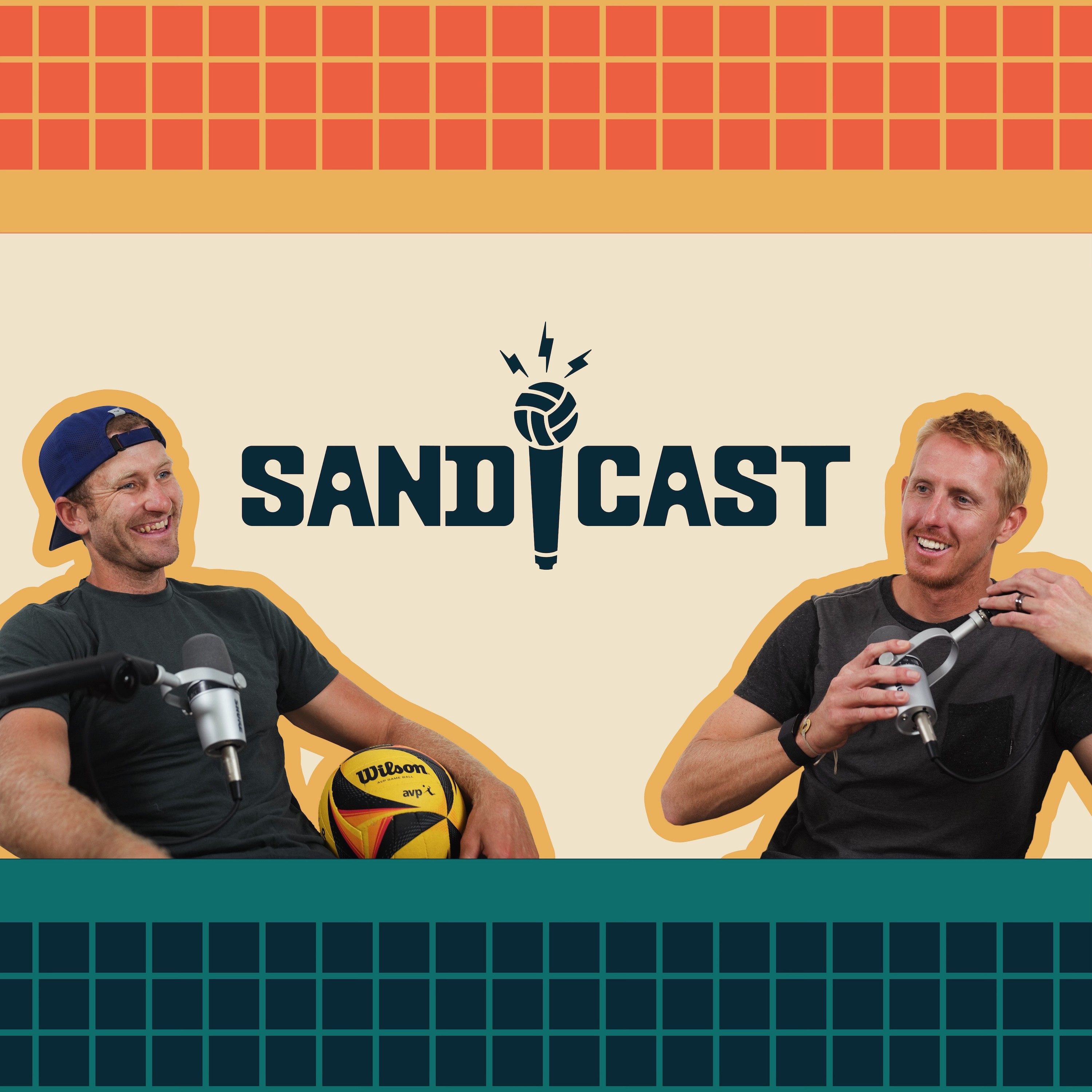
1.1M
Downloads
467
Episodes
SANDCAST is the first and leading beach volleyball podcast in the world. Hosts Tri Bourne and Travis Mewhirter take listeners into the world of the AVP, Volleyball World Beach Pro Tour and any other professional beach volleyball outlets, digging deep into the lives of the players both on and off the court as well as all of the top influencers in the game.
Episodes
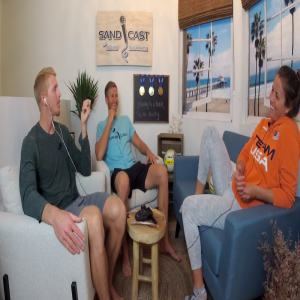
Wednesday Feb 06, 2019
Brooke Sweat: From considering retirement to playing with the GOAT
Wednesday Feb 06, 2019
Wednesday Feb 06, 2019
It’s funny, sometimes, the path the universe can choose to take you. One minute, you’re lying on a training table, your torn shoulder being worked on. You’re pondering if this is it, the last tear. Perhaps it’s time to move back to Florida. Have kids. Raise a family. Move on.
The next, you’re on a call with Kerri Walsh Jennings, the greatest to ever play the game, one of the most dominant athletes not only in the sport of beach volleyball but of all time. She’s looking for a partner, someone to make a run at the Tokyo Olympics. You’ve been to the Olympics before. You fell short, going 0-3. The sting is still there. You want more.
So you take the offer. Your career isn’t over. In fact, this may just be the beginning.
This could be the exact moment everything – the knee surgeries and shoulder tears, moving across the country to a state you never wanted to live to, making a career out of a game that you didn’t pick up until after college – has circuitously led to. Maybe this is the reason for all of that.
Such is the story of Brooke Youngquist Sweat, one filled with tremendous adversity but magnificent toughness, both of the mental and physical sort.
She never meant for beach volleyball to be a career. Her boyfriend in college, Nick Sweat, played. Every now and then she’d hop in. She gave it a go for a bit but didn’t like it much. Wasn’t for her.
Then she tried again. Suddenly, the gal from Estero, Fla., the one who would work on her dad’s rock quarry over the summers, was moving to California. Suddenly she was traveling to AVP qualifiers. And then she was qualifying. And winning.
Suddenly Brooke Sweat had become the very personification of all things Southern California, the one chasing a pipe dream on a beach, dropping everything to do so, traveling with the rolling circus of grinders and hopefuls that is the AVP Tour.
Only it was working.
It was in 2012 that Sweat moved to California. Not coincidentally, a year later, partnered with Jen Fopma at Huntington Beach, she won her first tournament. When she wasn’t winning, she was contending, as Sweat, in 2014 with Fendrick, made five straight finals, meeting the same foil every time: Kerri Walsh Jennings and April Ross.
“I just wanted to be on the court against her, she’s always going to make me better,” Sweat said. “I never thought I would be playing with Kerri. Like, no. So it’s kind of cool to be in this position, especially after not knowing if I was going to be playing ever again.”
So now here she is. Her knee is healthy. Her shoulder, as is Walsh’s notoriously troublesome shoulder, is rebuilt. On the road with them will be physical therapist extraordinaire Chad Beauchamp.
The next two years will be the final push for both Sweat and Walsh Jennings. And then Sweat will return to Florida, where her heart has always been. It will have been a long and winding journey, though what else would you expect from this wonky universe of ours?
What fun would the straight path have been, anyway?
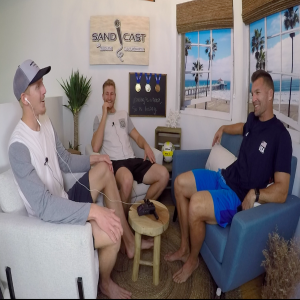
Wednesday Jan 23, 2019
Rich Lambourne: The humble, self-deprecating, sarcastic gold medalist turned coach
Wednesday Jan 23, 2019
Wednesday Jan 23, 2019
The talk always turned to Taylor.
As Taylor Crabb and Jake Gibb grew and developed as a new team, climbing the world ranks, piling up wins that once could have been perceived as upsets – over 2017 World Champs Andre and Evandro, over Phil Dalhausser and Nick Lucena, over Italians and 2016 silver medalists Paolo Nicolai and Daniele Lupo – most looked to Crabb, the 26-year-old quicksilver fast defender, as the reason for that success.
It’s a justifiable stance, and not entirely wrong. But Gibb, appearing on SANDCAST: Beach Volleyball with Tri Bourne and Travis Mewhirter, while giving Crabb his due, also pointed to another source of that success: Rich Lambourne.
“We’ve got a guy with a gold medal around his neck,” he said.
Not that you’ll hear Lambourne mention that gold medal, earned as a libero on the U.S. indoor team in the 2008 Olympics. In nearly an hour on SANDCAST, it came up just once, in passing. The vast majority of his many accolades went unmentioned as well – Best Libero of the World League in 2007, NORCECA Continental Championship 2007 gold medal, being named best libero as the U.S. won their first World League title in 2008, the fact that he played in every set of the Beijing Olympics in which the Americans won gold.
No, that just wouldn’t be Lambourne, a paragon of humility, self-deprecation and sarcasm. A struggle of many players-turned-coaches is turning off the player inside them, one that Brazilian Jose Loiola admitted he struggled with. Lambourne laughed. He had no such struggle.
“What’s been interesting to me, it’s been a huge and ongoing learning process for me because I don’t have personal, professional frame of reference to the game,” Lambourne said. “Jose has 20 years of repetitions and tournaments that he went through in this particular discipline of the sport, and I don’t. I have, I think, some technical expertise that has some high degree of transfer that I can bring, but the rest of it – strategy, how can we accomplish getting that team out of system, or how can we accomplish putting them in positions we want them to be in that are advantageous for us, it’s vastly different outside than it is inside. So all that stuff is stuff I had to learn, stuff that I’m still learning, that’s still evolving.
“So that’s been the challenging, and what’s been fun.”
They’ve created a collaborative dynamic, Lambourne, Gibb and Crabb, begat from three vastly different perspectives on the game. Lambourne is the indoor specialist with a sharp mind for the game. Gibb is one of the all-time greats, a three-time Olympian with a likelihood of making that four. Crabb has set himself firmly in the conversation as one of the best defenders in the world.
“I try to bring what I have to them, and they try and fill in the gaps with, in Jake’s case, 20 years of experience at the highest level,” Lambourne said. “And in Taylor’s relatively short career, how much amazing stuff has he done? So I’m never going ‘Uh, no, let’s do this.’ I’m saying ‘Here’s what I think, here’s what you think, so let’s decide so we’re all on the same page.’”
That same page, at the moment, has put Crabb and Gibb as arguably the best team in the United States. It's put them on track for Lambourne to appear in his third Olympics, Gibb his fourth, Crabb his third. Just don't expect Lambourne to take much, if any, credit.
"No, I take full credit for Taylor's success," Lambourne said, laughing.
So there it is, the only type of credit Lambourne will take: the sarcastic type, full of self-deprecation, and nothing about the gold medal hanging from his neck.
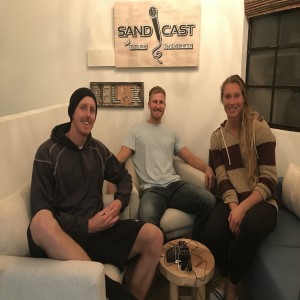
Wednesday Jan 16, 2019
Carly Wopat: Transitioning from indoor's highest level to beach's
Wednesday Jan 16, 2019
Wednesday Jan 16, 2019
Carly Wopat acknowledges that there are a number of skills that need to be refined, so be smoothed over, to be fully beached from their indoor counterparts. But she’s been an athlete all her life, a state champ in high school, an All-American at Stanford, a professional overseas. It’s simply a matter of time for most, and anyway, the majority of the fundamental skills are already there. There’s just one that gives her pause: setting, and hand setting.
“Initially I just wasn’t squaring up,” she said on SANDCAST: Beach Volleyball with Tri Bourne and Travis Mewhirter. “It took a long time for me to just square up every time. I kept trying to angle the sets. I’m starting to get good at squaring up but I want to get better at hand setting and that’s the most difficult thing for me right now: hand setting.
“The indoor hands are so different from the beach hands. I’ve gotten to the point where I know how to set a good ball, what it feels like, I just need to be able to do it consistently.”
Anyone who might doubt Wopat’s ability to do so likely just doesn’t know much about Carly Wopat.
This is a 26-year-old who, as a senior in high school, led Dos Pueblos to a CIF title and followed it up by setting a school record in the discus.
This is a girl who, while majoring in human biology and dabbling with a minor in art at the most prestigious university in the country, led the Pac-12 in blocks per set (1.43) and hit .392 for her career, good for second all-time at Stanford.
This is a girl who taught herself to play guitar, who speaks French and can also drop the occasional Turkish – “I don’t know why, but it just stuck with me,” she said – and Japanese. This is the daughter of a man who nearly qualified for the 1980 Olympics in track and field and a mother who competed as a gymnast in college.
And hand setting could potentially be an issue? No way.
In fact, it is the very difficulty of the sport, the fact that one couldn’t simply be a decent athlete and succeed, that drew her to volleyball in the first place. It is the need for these reps, the proverbial 10,000 hours, that she loves the most.
“I like the speed of it,” she said of volleyball. “It’s an interesting sport. It takes a lot of skill. There are some sports where you can be really athletic and just go out and be really good at, like you can run and go be a track athlete or something like that. But with volleyball, there’s so much skill involved that it takes years and years to cultivate just hand-eye coordination and the feel for the ball. Just things that only come with experience I guess, perspective of the court and so I really liked that part of the game, that I could work on these skills and be really athletic and go out and play this game.”
And in limited experience on the beach, she has already excelled, making two main draws – in San Jose and Huntington Beach – to end the 2018 season, taking fifth at p1440 Huntington Beach alongside Corinne Quiggle. With those resume points, despite zero FIVB points to her name but the desire to play overseas, she got a call from one of the most experienced United States defenders, Brittany Hochevar.
“Hochevar messaged me while I was still playing in the p1440s and asked if I wanted to meet up,” Wopat recalled. “I think she had done her research and watched me a little bit and maybe talked to some people, so we met up and discussed playing together, and she just kinda has this dream to go to the Olympics for 2020 and we talked a lot about timing, and our partnership – I don’t know, just the timing of it all just works out really well.
“The more I’ve gotten to know her spirit and energy – she’s just an amazing person. I just think we’re going to make an amazing partnership.”
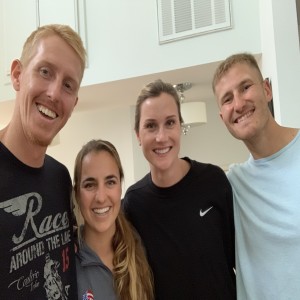
Wednesday Jan 09, 2019
SNOWCAST: Emily Hartong and Katie Spieler
Wednesday Jan 09, 2019
Wednesday Jan 09, 2019
There they stood, the four Americans, bundled in four to five layers of UnderArmour and other form-fitting warm weather gear. Bundled in beanies and gloves, headbands and, underneath it all, hand and feet warmers tucked in their makeshift soccer cleats and gloves.
They – Emily Hartong, Katie Spieler, Karissa Cook, Allie Wheeler – had descended upon Moscow, Russia less than a week before Christmas to play volleyball. It does not take an astrophysics major or scientist or really anybody with exceptional intelligence to determine that this was not the typical volleyball tournament. It wasn’t on a beach, where they are all pursuing careers. No, this was on snow, not a surface befitting three who earned degrees from the University of Hawai’i and another from USC.
“We were compared to the Jamaican bobsled team,” Spieler said, laughing, on SANDCAST: Beach Volleyball with Tri Bourne and Travis Mewhirter. In a way, the comparison fits. Few would expect Americans to specialize in a sport that is legitimately never played on U.S. soil, aside from a lone exhibition at Mammoth Mountain in 2017. And yet, the comparison doesn’t really fit at all, for while the famed Jamaican bobsled team, which made their Olympic debut in 1988 and is the subject of the wonderfully popular film, Cool Runnings, was more of a gimmick, failing to finish their qualifying run, the Americans ran the table.
Five straight matches they won, closing with a three-set win over Russia in the finals.
“It was crazy,” Spieler said. “Definitely the best team we played was that Russian team we played in the finals. They were scouting us for at least an hour, with their coach, in the V.I.P. tent, so intense. Karissa had to go back to the tent to grab her bookbag and they went silent, like ‘Whoa.’ We were so confused at what they were scouting because we just had no idea what we were doing on the court. We were just kinda going for it out there.”
It doesn’t really matter what surface it is for Spieler. She has won on the beach, as she did at Seaside, one of the biggest non-AVP or p1440 domestic events of the season, this year alongside Cook. She has won on dirt, as she did with Cook at a NORCECA in Martinique. And now she’s done so in the snow, though with a bit different of a wardrobe.
“Hand warmers were super key,” Spieler said, to which Hartong agreed, mentioning she had two in her shoes.
“All in the toes,” she said, laughing. “Arch was fine. It was all really interesting. It was fun, though. It was so much fun.”
Hartong, too, has enjoyed success at every level, and now on every surface. She won a state title at Los Alamitos High School, was a two-time Big West Player of the Year at Hawai’i, named the Best Foreign Player on her pro team in Korea, qualified for the Hermosa and Manhattan Opens in her first year on the AVP, and is now a gold medalist on the snow.
“We had a really good time, laughing on and off the court,” Hartong said. “I wouldn’t be surprised if it does become a sport.”

Wednesday Jan 02, 2019
Tri Bourne, Trevor Crabb: Making the split-blocking push to Tokyo
Wednesday Jan 02, 2019
Wednesday Jan 02, 2019
It began as something fun. Nothing much more than, well, why not? Why not put two childhood friends on the same team? Friends who play the same side, the same position, who had never played defense at a professional level.
And yet there Tri Bourne and Trevor Crabb were, winning in Manhattan Beach, finishing with a seventh. Winning in Chicago, improving to fifth. Winning in China, claiming a gold medal. Winning in Hawaii, making a Sunday. Winning in Las Vegas, nearly stunning Russia’s top team, Viacheslav Krasilnikov and Oleg Stoyanovskiy, for a bronze medal. Winning despite Bourne not having played for nearly two years. Winning despite Bourne tweaking a rib. Winning despite neither of them really having any clue what to do on defense at the game’s highest level. Winning despite neither having played much right side in their careers.
And now here we are, in 2019, with the Olympic race beginning in earnest this week at The Hague, and Bourne and Crabb, the team that few, even themselves, predicted to be legitimate contenders, or even a team at all, are training full-time, pushing for a berth to Tokyo in 2020.
“We’re gonna stick with our plan,” Bourne said on SANDCAST: Beach Volleyball with Tri Bourne and Travis Mewhirter. “We’re still a new partnership, obviously. Last time we played in 2018 it was a honeymoon phase, even though me and Trevor have been playing against each other our whole lives. We had a lot to figure out, were just winging it at the end of 2018, so now we gotta figure out what our system is, figure out how the hell to play defense, and so I’m excited.”
The commitment establishes Bourne and Crabb as the only split-blocking team in the U.S., and one of the few in the world at the game’s highest level. Currently, Spain’s Pablo Herrera and Adrian Gavira, Latvia’s Janis Smedins and Aleksandrs Samoilovs and Brazil’s Evandro Goncalves and Andre Loyola are the handful who have been able to succeed with neither partner specializing in either defensive position.
“You just feel like you should specialize because the rest of the world is,” Bourne said. “I’m super excited about it. I’ve always taken a lot of pride in being able to do every skill. Indoors, I played libero a little bit at USC, played middle blocker, so I’ve taken a little skill set from each position indoors and that’s what’s developed me for beach. I didn’t like being a specialized blocker even though it’s my favorite skill and the one I probably took the most pride in the last five years.
“But now I get to do it all. I’m stoked on that.”
He knows there’s going to be a learning curve, that their quick success was perhaps aided by the unconventional style and the lack of preparation teams could do against them. Which is why the Olympic race is not a sprint, but a two-year international grind, one Bourne and Crabb are now set on doing together.
“At the end of the year, we both took some time, and we weren’t for sure going to play with each other, we took time to figure out what was best for ourselves individually, but we both kind of came around – this is too fun,” Bourne said. “Why not, you know?”
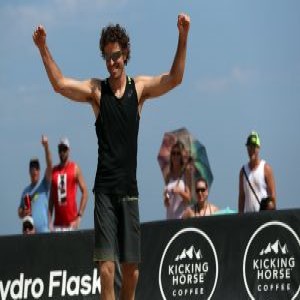
Wednesday Nov 21, 2018
John Mayer turns focus to full-time coaching
Wednesday Nov 21, 2018
Wednesday Nov 21, 2018
It’s fitting that John Mayer would spend much of his retirement podcast talking about everyone except John Mayer.
Much of it was spent discussing Trevor Crabb, despite Mayer even catching himself midway through and mentioning that he didn’t want it to be “a full Trevor Crabb podcast.” It didn’t stop him from singing Crabb’s praises further, though, nor did it stop him from elaborating on the positives of former partners Jeremy Casebeer, Ryan Doherty, Brad Keenan as well as his podcast partner, Billy Allen. Almost anyone who Mayer came into contact with over the course of a career that spanned from 2003-2018, he made sure to bring up.
It was a podcast as fitting as the manner in which he made his retirement known, which is to say, completely on accident.
“I didn’t want to make a deal of it,” he said on SANDCAST: Beach Volleyball with Tri Bourne and Travis Mewhirter. “I had known this year – it’s just been so hard to do LMU and play at a high level, and I felt like I was being average at both. And plus, my passion’s gone to coaching. I just love it, I get consumed by it. I thought this might be my last year [playing]. I just thought I’d see how I feel in the off-season, if I felt like I was missing something. I still loved all the coaching and I wasn’t missing the lifting and conditioning.
“I told my wife on our way to the AVP banquet, because she’s the one who would say something, just ‘Please don’t say anything. I don’t have a speech prepared, not that anyone would care’ but I knew she might say something to Mark [Schuermann, the AVP’s emcee]. She said ‘Oh, yeah, I won’t say anything,’ so the night was going through fine, ‘Alright, I’m off the hot seat, having a good time, just hanging out,’ and at the end of the night, Mark starts talking about me, and I’m like ‘What is he doing?’ And he says ‘Come up here!’ And I’m like ‘Why do I have to go up there?’ And he says ‘You gotta say something!’ My absolute nightmare.”
The reception, of course, was warm across the board. Quiet and humble, soft-spoken and endearingly self-deprecating, Mayer is retiring as one of the most respected players in the country, both for the way he played and the manner in which he carried himself.
Retiring, too, almost seems like a misnomer. He’s retiring as a player, yes, but Mayer actually might be on the beach more now than in the past decade. With the time he’d typically devote to the weight room, he’s now available to coach beach teams, the first of which to hire him is Billy Allen and Stafford Slick. He’s helping launch a beach division of Gold Medal Squared. He’s devoting more of himself to Loyola Marymount, the program he has helped improve from 6-17 to 15-14 to 22-14.
And even the unquestionable, objective improvement he has overseen at LMU, he had to shed the credit.
“I think I just scheduled more matches so we could get more wins,” he said, laughing.
Ah, yes, it’s never to his own credit. The four AVP wins, two FIVB gold medals, 2015 AVP, 2015 Best Defensive Player – all a credit to someone else who helped him along the way, be it a coach (“I owe Tom Black everything,” he said), a partner, his wife, anyone.
That’s Mayer. He even mentioned that perhaps he would have had a more successful career in spots had he chosen to focus on improving himself a little more as opposed to always, always, always attempting to bring the best out of his partner. But that just wouldn’t have been Mayer.
He’s a coach, after all. Through and through.
Now he’s set aside to become the best he can be at that, a role in which his own improvement will mean the inevitable improvement and development of those around him.
A role befitting the man who has always put others first.

Wednesday Nov 07, 2018
Wilco Nijland, creator the King of the Court series
Wednesday Nov 07, 2018
Wednesday Nov 07, 2018
You’d have thought he was busy enough, Wilco Nijland. His plate of responsibilities includes only, oh, a 10-stop beach volleyball tour in the Netherlands, his role as the Controlling Operations Officer at Sportworx, and subbing in as the coach for the Dutch team of Sophie van Gestel and Marloes Wesselink.
Why not add an entire new concept, a four-stop, international beach volleyball tour, on top of all that?
In a year that was replete with new developments – a massive event to kick off the AVP season, a domestic invitational in Hawai’i, record FIVB events, the establishment of p1440 – Nijland’s brainchild, King of the Court, was the smash hit of 2018.
“It was 15-20 tournaments in a row,” Nijland said on SANDCAST: Beach Volleyball with Tri Bourne and Travis Mewhirter. “It was a lot. And, of course, it was the first time with the King of the Court so there was a lot of pressure. And the world was watching us so at times it was very heavy, but most of the time it was very good.”
All of the time, it seemed, it was very good. It was good for viewers, who packed stadiums in the Netherlands, Belgium, Hawai’i, and Huntington Beach for all four events. It was good for players, who were treated like, well kings, with hotels for a week, events every night – Dodgers games, dinners, parties, surf lessons, the works. It was good for the game, which received a jolt of fresh energy, a new format, new partnerships – the Netherlands’ Alex Brouwer and Russia’s Oleg Stoyanovskiy, for example, or Aleksandrs Samoilovs and Martins Plavins – and a pace of play that was at once exhilarating and fascinating.
“It’s so extremely fast. If you take a look in the stadium and you’re sitting there for five minutes, you already saw three amazing rallies going on. It’s completely different from normal beach volleyball, which is already fun. It’s a next level thing, I guess.”
Five teams play on a single court, in a hyper-speed display of offensive prowess and the occasional bicycle kick, the method used by Austria’s Alexander Horst to score a point in Utrect, the first event of the series.
“It’s engaging the entire time,” Bourne said. “The fans are getting to watch three plays in the time it would normally take one, but you’re also thinking strategically: ‘What should this team be doing? What are they trying to do?’ You’re constantly looking at the score so the fans are engaged the entire time.”
Bourne competed with Trevor Crabb in the Hawai’i and Huntington Beach King of the Court events, eliminated early in Hawai’i due to some alliances formed against them in order to push another team through to the next round.
By the next event, such tactics were banned, as the rules are still in constant flux, able to change on the fly.
“Each tournament did something a little better,” Nijland said.
And there will continue to be more tournaments. Four more, which will be cooperatively scheduled with the FIVB, is the plan for 2019, with designs on adding events all the way up to 10.
“Of course, there were things going wrong but it went very smooth and we succeeded in adding a different kind of beach volleyball format in the beach volleyball world,” Nijland said. “It was very successful because the players like it a lot, the fans like it a lot, the FIVB thought it was fantastic. We have some good partners. We can be very proud of our team and we can be excited about the possibilities we have.”

Wednesday Oct 24, 2018
Jeff Alzina: Architect of beach volleyball powers
Wednesday Oct 24, 2018
Wednesday Oct 24, 2018
In 1997, there were six countries with beach volleyball coaches for their national teams. Perhaps one of the most unqualified to do so was one of them.
Jeff Alzina had never coached on the beach prior to ’97, nor had he ever really played at much of a high level, having made just one AVP main draw, in Chicago of 1992. But he still trained with the top guys, setting up drills and competitive practices, making it so that his “biggest experience [on the beach] wasn’t necessarily competing at a high level, but training at a high level,” he said on SANDCAST: Beach Volleyball with Tri Bourne and Travis Mewhirter.
Being the practice guy everyone turned to paid off far more than being one of the top guys there to practice.
In September of 1997, the FIVB held a stop in Los Angeles, at the UCLA tennis center. Not long prior, Athens had been awarded the bid to the 2004 Summer Olympics, meaning Greece would have a bid for a beach volleyball team. Only, they didn’t have a team to send. So a few Greek representatives went to the U.S., then the unquestioned beach volleyball powerhouse of the world, to recruit someone who could launch their beach program. It would be someone young, preferably without a family, seeing as they’d have to relocate to Greece. Someone crazy enough to take on a beach volleyball program without a single beach volleyball player.
Someone like Jeff Alzina.
“They liked the way I worked with young people and thought I’d do a good job,” Alzina said. “So I was the national team’s director and head coach for men’s, women’s and junior volleyball.”
He got an apartment, was assigned an assistant, and then began scouring the country for beach volleyball players, with the goal to recruit a team who might become good enough to be competitive by the time the 2004 Olympics rolled around.
Alzina had a more expedited mission in mind. He found two indoor players by the names of Vasso Karadassiou and Efi Sfyri. They had played a few beach events, enough to be ranked 63 in the world.
Within a year, they were ranked No. 12, qualifying for the Sydney Olympics.
“It was surprising to a ton of people but I saw the talent in them right off the bat,” Alzina said. “To this day, I think the right-sider, [Karadassiou], was one of the best right-side defenders to ever play the game. They won a European Tour stop they had never won – they had never even medaled. So these girls just became national heroes and the federation went bananas too and went ‘Oh my God, let’s keep funding this thing. This is great.’ So the national tour grew, the juniors tour grew, those girls went on to be legends.”
And the legend of Alzina began. In Sydney, Alzina ran into Barbra Fontana, one of the best to ever play the game for the U.S. She had seen the work Alzina had done with Greece and offered to hire him to coach her and Elaine Youngs.
“After that hire, Elaine was good friends with Kevin Wong, Kevin said Elaine had only told him good things and…” the rest, you could say – and Alzina later would – is history.
He was hooked. And because he still hadn’t been coaching for long, his learning curve remained steep. He watched 25 hours of film a week, cutting it up on VHS tapes he still has at home. He began statting matches, reading everything he could get his hands on.
“It was like getting your 10,000 hours of coaching in one year,” he said. “It’s just a little bit of dumb luck, right place, right time, with some motivation.”
Since leaving the Greek program, Alzina has coached nearly three dozen Olympians and several hundred professionals in 83 open finals and counting. He has coached the USAV’s Elite Developmental Program and is currently overseeing its youth teams, which recently returned from a successful trip in Argentina, with two top-fives from the boys and girls teams.
This year, he helped with Trevor Crabb, who not coincidentally enjoyed the most successful year of his career internationally, with two gold medals and nearly a bronze in a four-star Olympic qualifier in Las Vegas.
In January, he got the call from Stein Metzger, whom Alzina coached in the 2004 Olympics, asking if he’d like to be his volunteer assistant. Alzina left a post at Long Beach State, where he had helped turn a program around from 13-14 to 26-10 in two years, and took the volunteer spot with the Bruins.
Metzger told the Daily Bruin that with Alzina, UCLA might be able to become a top-five team in the country.
In May, they won their first National Championship.
“I kinda thought Pepperdine was going to win it all and I thought USC had the talent to be in the finals again,” Alzina said. So it wasn’t going to be easy. He knew that. And when they lost in Gulf Shores to Florida State in their second match, he didn’t turn to the film, as he is wont to do, or to more reps, or to the weight room. No, one of the best coaching moves Alzina made as a Bruin was take the girls mini golfing.
“After that game, one of our freshmen said ‘I got something to say,’” he recalled. “And she said ‘Guys, we were supposed to lose this game. This year is not supposed to be a runaway for us. We’ve got to have a wakeup call and we’ve got to grind and that was the loss we needed. And it just sent this chill vibe to everyone where we’re not panicking, not going back to video to find out what was wrong with them. They just had to shed something off their back and look forward and be positive, and they did.”
So underestimate Alzina if you will. But from Greece to Fontana to the USAV youth to Crabb and now UCLA, Alzina is going to find a way to get his team – guys or girls, old or young, foreign or domestic – to win.

Wednesday Oct 17, 2018
The view from the Top of the World, with Norway's Anders Mol and Christian Sorum
Wednesday Oct 17, 2018
Wednesday Oct 17, 2018
John Mayer stood outside the player’s tent, not looking particularly disappointed despite being knocked out of the Huntington Beach Open less than an hour prior. He and Trevor Crabb had played their best match yet, he said.
Norway’s then-relatively unknown youngsters, Anders Mol and Christian Sorum, had simply played better.
“The blocker,” Mayer said, “reminds me of Phil [Dalhausser].”
A 20-year-old kid? Compared to Phil Dalhausser?
Had it been almost anyone else making that statement, an eye roll, a sigh, would have been acceptable. But Mayer isn’t one to simply dole out hyperbolic comments or undeserved praise. By year’s end, his comparison didn’t seem absurd, rather prescient.
Eight months later, Mol and Sorum are the undisputed best team in the world, and indeed, Mol was named the FIVB Blocker of the Year, with Sorum claiming Defender of the Year. As a team, they won Gstaad, and Vienna, and Hamburg, and then made yet another final in San Jose.
“If you would have told me at the beginning of the year that anyone would win three tournaments in a row,” Sorum said on SANDCAST: Beach Volleyball with Tri Bourne and Travis Mewhirter, “I would have said absolutely not.”
Perhaps only Mayer could have foreseen it. There’s no real reason anyone could have forecasted the breakthrough, not to these heights, at least. Prior to the Gstaad Major in mid-July, a Norwegian beach volleyball team hadn’t won a medal since 1997. The same year Mol was born.
It was uncanny, their poise in such a moment.
“We didn’t think about that at all,” Mol said. “You can’t think about that at all or you’ll lose. You have to stay in your own bubble. We don’t think about the crowd. We don’t think about what if we win and what can happen if we win. We just think about our game and the next ball and what we’re going to do and make a plan for every ball.
“When you see the videos we are really calm and really focused and not that many emotions from us.”
“We also,” Sorum added, “had a little bit of luck.”
They’re endearing, these Norwegians. Impossibly humble for such accomplished athletes, ones who rose from the qualifiers to the top of the world in half a year’s time. It’s a humility begat from both being products of a small town – Mol’s village has 500 “inhabitants,” as he described it – and taking the time to see the world in all of its massive beauty.
They’re volleyball players, yes, but they’ve taken on much more than that. They don’t simply bounce from hotel to hotel, AirBNB to AirBNB. There’s more to life than volleyball for them.
“I was sad for like two minutes in Hawai’i,” Sorum said, “and then I was like ‘Yes! We get to go see Hawai’i!’”
“I was stoked!” Mol’s brother, Hendrik, a University of Hawai’i alum, added.
They’ve explored, drinking in not just the beach volleyball life but the lifestyle that comes with it. In the gap between Warsaw and Espinho, Portugal, they saw a good deal of Poland. After getting knocked out in Russia, they saw Jay Z and Beyonce. Between San Jose and Las Vegas, they’ve become honorary South Bay residents after checking Yosemite off the bucket list.
It’s how they stay fresh, enthused, thrilled about this warp-speed lives their living.
“I think that’s really important just to get our minds off of volleyball for a little,” Mol said. “There is so much volleyball and also, in our family, we talk volleyball all the time. It’s really good just to get some days off when we’re not playing. I think that’s really important to keep our minds fresh and not always think about volleyball.”
While they give their minds a rest from volleyball, nearly everyone in volleyball is thinking about them.
“This off-season,” Jake Gibb said, “there’s going to be a lot of Norwegian film going around.”
You don’t have to look hard for it. They upload every match, along with highly entertaining vlogs of their travels, onto their YouTube channel, Beach Volley Vikings, for all the world to see. And that’s exactly the point: They want to grow the game. If they can put out information that will help others learn, that’s exactly what they’ll do.
“Just watch some video of these guys,” Hendrik said. “It’s great learning from these guys. They’re great athletes, they have some of the best technique in the game. Check them out for sure.”
Lord knows the rest of the world is.
As for the Norwegians?
They’re checking out the rest of the world.

Wednesday Oct 03, 2018
The World Tour-cast with Norway, Canada, Latvia, United States
Wednesday Oct 03, 2018
Wednesday Oct 03, 2018
Martins Plavins requested the mic from Aleksandrs Samoilovs. Had to set some matters straight.
“I know,” Plavins said on Saturday night at p1440 San Jose, “that Edgars misses me.”
He was joking – maybe, possibly, perhaps – but Sunday’s result, when the Latvians upended the world’s best in Norway’s Christian Sorum and Anders Mol in the finals, proved that there’s likely a bit of truth to the notion that Edgars Tocs, Plavins’ typical partner, may have been missing his defender.
Plavins and Tocs, Latvia’s No. 2 team behind Samoilovs and the injured Janis Smedins, were one of the world’s most delightful surprises in the 2018 FIVB season. Entering the year, Tocs, a 29-year-old from Madona, had never eclipsed the five-figure threshold in prize money, with just three main draws to his name in all of 2017.
Yet there they were, on podium after podium to begin the year – gold at The Hague in January, silver in Kish Island a month later. By the end of the year they had played in 13 events, nearly as many main draws as Tocs had played in his entire career.
By season’s end, they were ranked fifth in the world, three spots behind Samoilovs and Smedins, and a country that is roughly the size of Nebraska in terms of population was suddenly home to two of the world’s beach volleyball powers.
Not that Latvia is an upstart. Not by any means. Ten years ago, Samoilovs and Plavins authored arguably the greatest upset in Olympic beach volleyball history when they stunned Phil Dalhausser and Todd Rogers in the first round of pool play. In 2012, Plavins did it again, this time with Smedins, upsetting Jake Gibb and Sean Rosenthal – then the No. 1 team in the world – in the quarterfinals of the 2012 Olympics in London.
“We used to play good together,” Samoilovs said. “[Martins] agreed to come to San Jose so I’m very happy he had a chance to join me.”
In two years, for the second time in three Olympics, they might very well join each other as teammates on separate teams. While Plavins was winning a bronze medal with Smedins in 2012, Samoilovs took a ninth with Ruslans Sorokins.
“Martins is one of the best defenders in the world,” Samoilovs said, which explained why, in San Jose, Samoilovs, typically a split-blocker, stayed at the net. “It doesn’t make sense to go block.”
Indeed it seemed they found the right defensive system, as they lost just one set the entire weekend in San Jose, to Austrian Olympian Alexander Huber and Leo Williams in the first round. After that, it was dominant win after dominant win, over Piotr Marciniak and Canadian Olympian Chaim Schalk, Spaniards Adrian Gavira and Pablo Herrera, Americans Miles Evans and Billy Kolinske and the world’s best in Noway’s Mol and Sorum.
More important for either than the winning, though, is the fact they have a chance to win anything at all. Samoilovs remembers what it was like post-2016, when the world tour had just eight events big enough for the best to play, when beach volleyball was somewhat of a wasteland.
With the advent of the King of the Court series and p1440, as well as the extension of the FIVB season, the sport has become nearly year-round.
“This is really great,” Samoilovs said. “I remember after the Rio Olympics, in 2017, it was a disaster. It was only eight World Tour events, so you spend three months preparation just to play eight weeks, two months, so for us players we’re relieved because of these tournaments. Our families live because of these tournaments. It’s important to have more opportunities and more tournaments to earn money and to have a better life.”